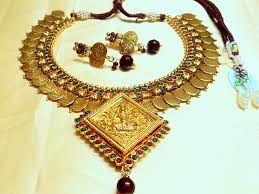The Heritage Of India
Temple Jewellery in South India has a timeless camaraderie with the land itself. Tradition has its roots deep delved into the soils of South India and as obvious result temple jewellery is of paramount vitality in the Dravidian land and even the foreign invasion could not cater any significant amount of loss of them. Most of this jewellery was donated by the people to adorn the deities of the temples.
History of Temple Jewellery in South India
Indian jewellery art is at times divided into three kinds’ temple jewellery spiritual jewellery and bridal jewellery. The statues In India were ornamented with chunky necklaces that were either strung with beads or crafted with intricate filigree. Amongst the other ornaments that adorned statues of deities were large chunky bangles, usually studded with gems. In addition, earrings, nose rings and anklets were also used. The jewellery used to garnish the idols was later worn by temple dancers and at a snail’s pace; the designs became a branch of the Indian woman’s nuptial jewellery trousseau. Though the idols in an unremitting way began to be highlighted with jewellery, a rehearsal seen even today, the jewellery of Indian women also came be made on the prototype. Today, temple jewellery has become unfastened to the most accepted crafts of India. At some stage in festivals and occasions of worship of Gods, women wear temple jewellery believed to be auspicious and offer good luck . check out Temple jewellery in Bharatnatyam Dance.
Jewellery items like pendants, bracelets, belts and brooches based on temple jewellery are very popular amongst women, during auspicious times, and wearing these is believed to bring fortuity to the person. The darling design for pendants is that of Ganesha the elephant headed divinity known to bestow good luck and good fortune. The other emblem, which is also, very much in claim, is that of the sacred syllable OM. These days, the temple jewellery of India is finding an aroma and quintessential zest amongst foreigners too.
With its roots in the epics and history, temple jewellery was initially made to adorn the deities of temples. Made in pure gold and studded with rubies, uncut diamonds and emeralds, they were a sight to behold. As life revolved around temples in the those days, and with the classical dances, especially Bharatnatyam, evolving in the temples,this jewellery, often called as the Kemp set, were patronised by royalty and the court dancers . The stones used in Indian temple ornaments are called Kemp stones. Un-cut polished stones in red & green, along with precious and semi-precious stones. They stones are used in necklaces, pendent’s, hip chains, earrings, chokers, nose rings etc. Temple jewelry made a grand comeback a few years ago . Temple jewelry is either sold by the ancient family clans or is replicated. Temple jewelry is a huge hit among the female buyers of all ages and graced the appearance of brides and guests at weddings. My mother has a pretty collection of temple jewelry which she has inherited and acquired over the years. The current trend of wearing temple jewelry has piqued my interest and ignited my deep admiration for them. check out Temple jewellery Online
The Traditional Jewellery Of South India Thereafter, in the 13th century AD, the Pandyas also contributed a number of jewelleries to various temples at Madurai, Srirangam and Chidambaram. But most of the existing gems in South Indian temples today can be traced back to the Nayaka period. Many Nayaka rulers renovated the old temples and built new temples as well as adorned them with gems and jewelleries. They also offered dresses and jewelleries in the names of the famous saints of Tamil Nadu. During the Chitrai festival at the temples of Goddess Meenakshi and Lord Alagar of Alagar Koil many types of jewellery were obtained as offerings. Most of these presents are still used at Madurai and Alagarkoil. The Nayaka period finest of gems and jewelleries can still be seen in temples at Mannargudi, Nachchiyarkoil, etc. of Tanjavur district.



